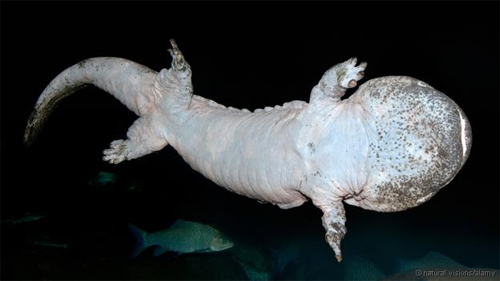Chinese giant toad fish faces extinction
As the world's largest amphibian, Chinese giant toad fish is facing the risk of extinction.
>> 10 endangered animals
>> Endangered wild sturgeon in China
The danger of extinction of the giant Chinese toad
 Body under Chinese toad, also known as salamanders.(Photo: Natural Vision).
Body under Chinese toad, also known as salamanders.(Photo: Natural Vision).
Giant Chinese toad fish is actually a salamander . They usually live in caves in the water, in large rocks, where females lay eggs. Males will protect and take care of eggs until the eggs hatch after more than a month.
Chinese salamanders are the largest amphibians in the world . Adults reach 1.8 m long, weigh up to 50 kg. However, the tadpole of this species is only about 3 cm long.
This animal appears in many Chinese folk legends and legends. Bagua, the famous yin and yang circle, was originally thought to symbolize two salamanders tangling together.
In China, this salamander species is also called "wa wa yu", meaning "newborn fish", because they have the same sound as babies cry. This species has an ancient lineage of the Cryptobranchidae family, a bisexual family of 170 million years ago.
Chinese toads are often referred to as "living fossils" , because they have characteristics close to ancient relatives.
"They haven't changed much since Tyrannosaurus Tyrannosaurus," said Andrew Cunningham, a member of the London Zoological Society.
However, this creature is increasingly rare in nature . Since the 1950s, the number of them began to decline significantly. Currently, this is one of the listed animals and the Red Book of threatened species of the International Union for Nature Conservation.
About a decade ago, the number of salamand farms in China is increasing. This may have affected the natural salamander population.
Iguana is considered a favorite in China , despite being protected. In addition, the huge size makes them a great source of lucrative food. Therefore, natural salamander is often hunted, sold for money and kept in farms. As a result, the number of individuals in nature decreases, by a salamander that takes five to seven years to mature.

"Wa wa yu", newborn fish, is a favorite of Chinese people.(Photo: BBC)
Previously, when the number was high, the hunting of this species was easy, Mr. Cunningham said. However, because this species is increasingly rare, many people use destructive hunting methods such as explosives, electric guns, including pesticides, which cause most animals to live around where the salamanders live. stand alone.
The punishment for poaching is negligible."There are even reports that security agencies buy them from poachers, then sell them to farms," Mr. Cunningham said.
Infectious diseases spread quickly on farms, threatening wild salamanders. According to a survey of the salamand industry in China in Oryx magazine, if the wild animal continues to be nurtured on farms, they will soon become extinct in the wild.
Understanding these risks, conservationists say they are planning to preserve this species.
" The toadfish industry is huge, Chinese central and local governments have invested a lot of money into it , " Cunningham said. "Closure of farms is not a viable option . "
Instead, farms need to be better managed. For example, do not drop farmed salamander in the wild.
According to the BBC, in the past, the Chinese government has encouraged the release of naturally kept farm salamanders to boost the number of wildlife. However, this is more harmful than good.
The released animals are not screened for disease, so it is possible that they spread the pathogen. They were also not tested on the gene for proper release to the natural environment. In addition, they are not monitored or evaluated overall considering the degree of failure of the project.
Cunningham and his colleagues suggested that natural toad and captive fish should be kept separately . Chips can be attached to captive animals to distinguish them from natural ones.
In addition, it is necessary to promote biosecurity and control pathogens in farms such as new barn isolation, waste water treatment to stop the discharge of pathogens into the natural environment.
However, Cunningham judged, first and foremost, the prospect of wild salamanders was still very gloomy, although tens of millions of children were living across 43 farms in China. Before they really regenerate, we need to change the notion of this species.
"This is one of the most amazing animals on the planet," Cunningham said. "Chinese people must learn to respect this particular species. Only that, this species has a bright future."

This prehistoric animal has a cry like a baby's cry.(Photo: London Zoo).
- Discovered a lot of particularly hardy toad fish in Phu Tho
- Discovered another species of toad fish in Vietnam
- Finding rare orange tail toad fish in Nghe An
- Toad Cane - The world's largest toad species
- Giant larvae of mud mud in China
- Exotic species of toad grows
- 11 strange frogs and frogs: Vietnam has 2 representatives
- Earth faces the greatest danger of extinction
- Fish walk at depths of more than 3,000 meters at the bottom of the sea
- Toad pretends to be a cobra to scare the enemy
- 11 species of giant fish are in danger of extinction
- Giant monster in the Amazon River before extinction
 Animal 'suffering' after hibernation
Animal 'suffering' after hibernation Why do goats climb well?
Why do goats climb well? Scientists were surprised to see chimpanzees eating turtles
Scientists were surprised to see chimpanzees eating turtles Giant catfish died deadly due to drought in Thailand
Giant catfish died deadly due to drought in Thailand